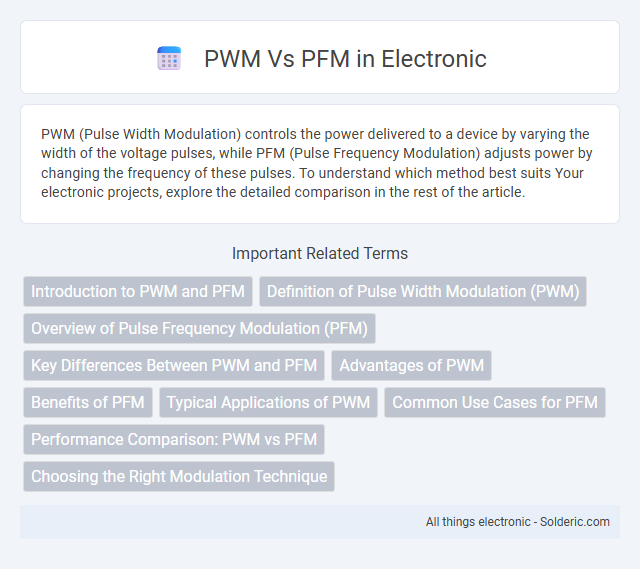PWM (Pulse Width Modulation) controls the power delivered to a device by varying the width of the voltage pulses, while PFM (Pulse Frequency Modulation) adjusts power by changing the frequency of these pulses. To understand which method best suits Your electronic projects, explore the detailed comparison in the rest of the article.
Comparison Table
| Feature | PWM (Pulse Width Modulation) | PFM (Pulse Frequency Modulation) |
|---|---|---|
| Definition | Controls output by varying pulse width at a constant frequency. | Controls output by varying pulse frequency while keeping pulse width constant. |
| Frequency | Fixed frequency | Variable frequency |
| Efficiency | Moderate efficiency; consistent switching losses. | Higher efficiency at light loads due to reduced switching. |
| Noise | Produces more electromagnetic interference (EMI) due to constant frequency switching. | Generally lower EMI because of variable switching frequency. |
| Complexity | Simple to implement with stable control. | More complex control due to frequency variation. |
| Application | Used in motor control, power supplies, and LED dimming. | Used in low power, low noise applications like audio amplifiers. |
| Output Regulation | Voltage or power regulated by duty cycle adjustment. | Output regulated by pulse frequency adjustment. |
Introduction to PWM and PFM
Pulse Width Modulation (PWM) controls power delivery by varying the duty cycle of a fixed frequency signal, optimizing efficiency in applications like motor speed control and LED dimming. Pulse Frequency Modulation (PFM) adjusts the frequency of pulses while maintaining a constant pulse width, enhancing performance in low-power scenarios such as battery-operated devices. Both techniques are essential for precise energy management in power electronics and embedded systems.
Definition of Pulse Width Modulation (PWM)
Pulse Width Modulation (PWM) is a technique used to control the amount of power delivered to electrical devices by varying the width of the pulses in a signal while keeping the frequency constant. This method enables precise control of voltage and current, making it ideal for applications like motor speed control, LED dimming, and power regulation. Your electronic projects benefit from PWM by achieving efficient energy use and smooth performance adjustments.
Overview of Pulse Frequency Modulation (PFM)
Pulse Frequency Modulation (PFM) controls output voltage by varying the frequency of pulses rather than their width, offering improved efficiency at light loads compared to Pulse Width Modulation (PWM). PFM reduces switching losses by decreasing the number of switching events, which benefits battery-powered devices where power conservation is critical. Your choice between PFM and PWM should consider load conditions and efficiency requirements to optimize performance.
Key Differences Between PWM and PFM
PWM (Pulse Width Modulation) controls power delivery by varying the duty cycle of a fixed frequency signal, ensuring consistent switching frequency and stable output voltage. PFM (Pulse Frequency Modulation) adjusts the frequency of pulses based on load demands, leading to variable switching frequency and improved efficiency at light loads. Your choice between PWM and PFM depends on the balance needed between noise performance, efficiency, and load conditions in power management applications.
Advantages of PWM
Pulse Width Modulation (PWM) offers superior efficiency in controlling power delivery by maintaining a constant switching frequency, which reduces electromagnetic interference and enables precise motor speed and brightness adjustments. PWM provides better thermal performance and stable output voltage, making it ideal for high-power applications requiring consistent performance. Your devices benefit from PWM's reliable control and noise reduction, enhancing overall system longevity and efficiency.
Benefits of PFM
PFM (Pulse Frequency Modulation) offers significant benefits in power efficiency, especially at light loads, by adjusting switching frequency to reduce energy losses. This modulation technique minimizes electromagnetic interference and heat generation, enhancing your device's overall thermal management and reliability. PFM is ideal for battery-powered applications, extending battery life through more precise power delivery compared to PWM (Pulse Width Modulation).
Typical Applications of PWM
PWM (Pulse Width Modulation) is typically used in applications requiring precise control of power delivery such as motor speed control, LED dimming, and voltage regulation in power supplies. It offers high efficiency and accurate output by varying the duty cycle of the signal, making it ideal for digital circuits and embedded systems. Your devices benefit from PWM's stability and predictability in applications demanding constant frequency and minimal electromagnetic interference.
Common Use Cases for PFM
Pulse Frequency Modulation (PFM) is commonly used in low-power applications such as battery-operated devices, where energy efficiency is crucial. It is ideal for systems requiring variable power delivery at light loads, including portable electronics and power management circuits. PFM reduces switching losses by varying the frequency instead of the duty cycle, making it suitable for devices like LED drivers and small DC-DC converters.
Performance Comparison: PWM vs PFM
Pulse Width Modulation (PWM) offers precise control over power delivery by varying the duty cycle, which leads to higher efficiency at medium to high load conditions. Pulse Frequency Modulation (PFM) adjusts the switching frequency in response to load variations, providing superior efficiency at light loads but increased ripple and noise at higher loads. In applications demanding consistent output with minimal noise, PWM is preferred, while PFM excels in battery-powered devices requiring extended runtime under low power consumption.
Choosing the Right Modulation Technique
Selecting the appropriate modulation technique between Pulse Width Modulation (PWM) and Pulse Frequency Modulation (PFM) depends on power efficiency and noise requirements. PWM offers consistent switching frequency ideal for applications demanding low electromagnetic interference, while PFM enhances power efficiency during light loads by varying switching frequency. Designing power supplies or motor drives requires balancing these factors to optimize performance and energy consumption.
PWM vs PFM Infographic

 solderic.com
solderic.com